It had been over a month since I have had any appreciable airtime, so when the forecast for Saturday shaped up nicely, I jumped on the opportunity to fly Short Divide. I launched at about 3:45 under sunny 85 degree skies into SW winds 16-18 mph.
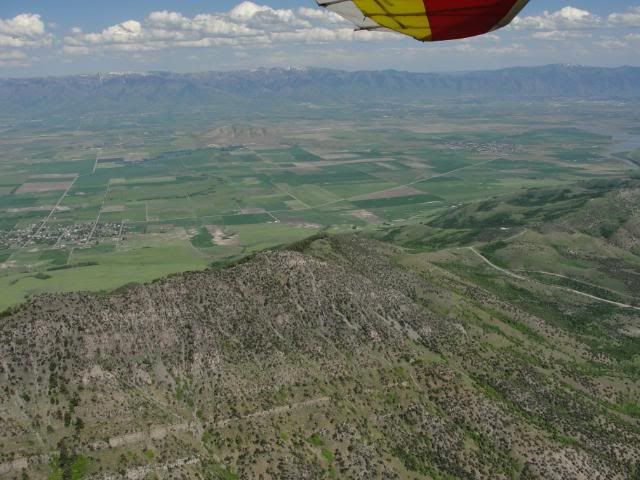
Short Divide is mostly a low thermal launch, but there is a short ridge which can be soared if you have to "hang out" between up-cycles while waiting for a "ride to the top." Over the years, I've noticed a bit of a pattern for our flights here, which was obvious in today's flight:
Pre-planning: A forecast with moderately strong SW winds, along with a reasonably optimistic soaring forecast indicates good to excellent potential at Short Divide. A last minute check of the mesonet current winds before the 25 minute drive will generally confirm that conditions on launch are good.
Launch Window: Generally speaking, there will be an optimal launch window which will allow for "benching up" over Clarkston and Gunsight Peaks. Weather Underground can be helpful to determine the time of day that the winds will peak - which is usually around 3 pm. I try to be set up by peak anticipated wind time, and then assess the conditions. Going cross country will generally require launching a bit earlier - around 1-3 pm, to allow for more flying time when the lift is strongest. Launching earlier requires a higher "bump tolerance" - a willingness to fly in some turbulent "rodeo air", and do battle with some strong thermals.
If I am just looking to bench up and catch the glass-off, or maybe have a nice extended tandem flight, I will launch just as the winds peak and begin to stabilize, indicating a slight mellowing - still good lift, but not as "rock'n roll." This was the window that I chose today, launching at about 3:45 pm.
Launch Timing: Exactly when to launch is also important - especially because Short Divide is a lower elevation launch. Even on a day with good lift, there can be up & down cycles. I try to watch the wind through one up, then down cycle before launching, so I can time it well and launch just as an up cycle is starting, to allow me to immediately climb above launch where I have a better chance to bench up. Today I timed it well, but didn't get quite high enough to go back and climb the mountain before the "down cycle" came through. I quickly found myself below launch, struggling to find lift.
Benching Up: Years ago I would have given up and landed, but experience has taught me to be patient, find the lift, and work it! I used my vario to help me stay in some zero sink over the cedar knoll below launch, more than once only one turn away from setting up to land. I focused on making very shallow turns to maximize my sink rate, and soon the zero sink turned into 600 fpm up, allowing me to continue climbing. I stayed in the drifting lift, and before I knew it I was on the face of Clarkston Peak where the lift was plentiful, allowing me to continue my ascent until I was over Gunsight Peak at 8,800' and climbing!
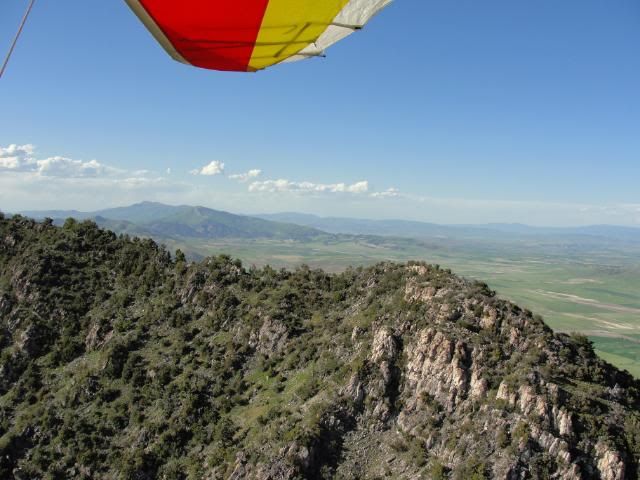
Generally speaking, once you bench up, the lift is much more plentiful, consistent and reliable. One of the great rewards of Short Divide is using your experience, skills and a little luck to climb out 3,000'+ over your launch elevation. I have always enjoyed climbing mountains on foot, but making the ascent in a hang glider results in a similar satisfaction - with even better outrageous views!
Go for Cloudbase: The next phase of most flights involves the "cat and mouse" game of coring the thermals and climbing as high as legally possible. This is one of my second-favorite parts of flying, because often times the lift just gets better and better the higher you get! The views just open up with each 360, until the patchwork valleys take on a Google Earth quality. At this point I am often joined by various raptors - today they include 2 Golden Eagles and 4 Red-tailed Hawks. On some days, the lift will only take me so high, until I bump up against an invisible ceiling. Sometimes persistence will allow me to break through this ceiling and continue to climb.
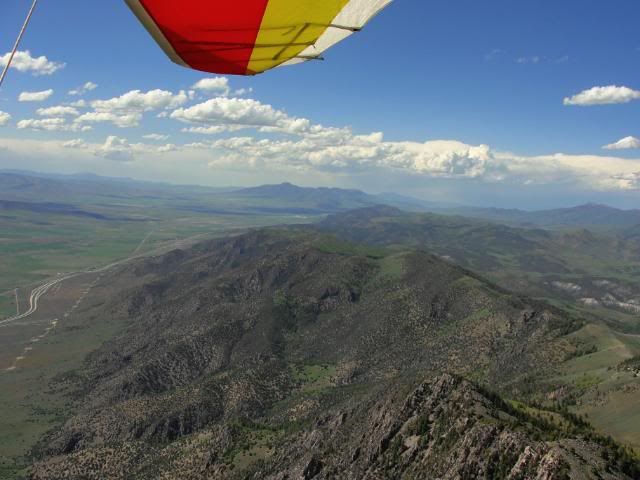
Decision Time: When I get above 10,000' the option of flying cross-country presents itself. I ask myself some key questions to make this decision: "Am I still climbing?" - Going XC in Utah generally (but not always) requires being able to climb consistently to at least 12,000' if not higher. "Am I physically prepared to go XC?" - Do I have warm clothes, water, food, radio, oxygen etc that I will need for climbing high and landing out? Am I in good overall physical condition? "Am I mentally prepared? - Is my head "in it", or do I have any distractions. Going cross country requires making a series of good, sound decisions in order to fly far and stay safe. "Do the conditions look good along my planned route?" - Is there a nice cloud street, or will it overdevelop and shut down? Are the winds aloft conducive to my planned route? Is the lift consistent enough - or is it one of those rare, "magical" days? "How will I get back?" - Do I have a chase driver below, or am I prepared to self-retrieve if needed? Can I afford to get home after midnight? Today I was prepared to go XC, but I could not climb any higher than about 9,600' over the top of Gunsight, so I decided to relax, explore and enjoy the flight.
Glass-Off: Most sites, generally in the summertime, to one degree or another, produce an afternoon/evening phenomena known as a glass-off - my favorite time of most flights! This is the time - usually between 2-4 hours before sunset - when the sun gets lower and the valley releases all of its stored heat, resulting in widespread abundant lift. The sharp-edged strong thermals soften, and what was a somewhat narrow lift band extends out over the valley - sometimes for miles! Some of these "wonder winds" will extend past sunset, even making it a challenge to get down. This time of the flight allows me to relax my grip on the control bar - or even fly hands-off - and just enjoy the magical air. These are the moments that are etched in my memories, which recharge my batteries for the coming ground-bound days ahead, as I have time to reflect, - and occasionally pinch myself to make sure I am not dreaming!
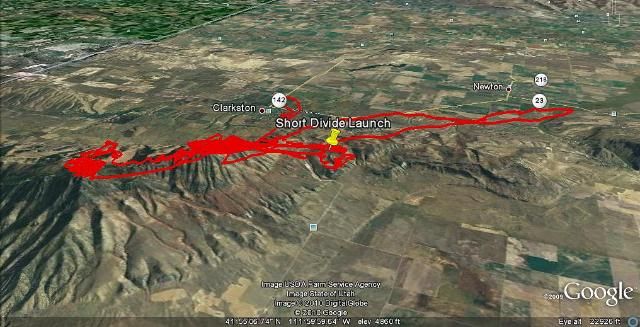
Today was just such a day. At about 5:30 pm I left the peaks, pulled on full VG and flew straight S/SE over the valley, as my vario chirped a smooth and steady 300 fpm up without even having to turn.
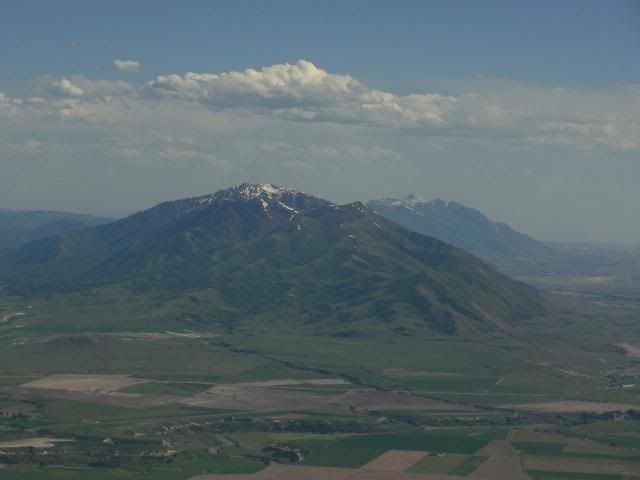
The view to the south of the Wellsville Mountains and Willard Peak was spectacular. The mountains, fields and valleys were all a vivid green from the recent Spring rains.
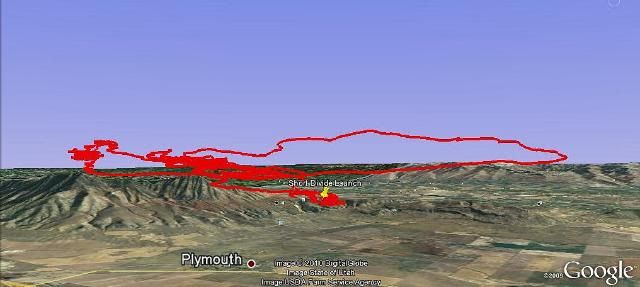
I topped out at about 10,600', and continued my southward course.
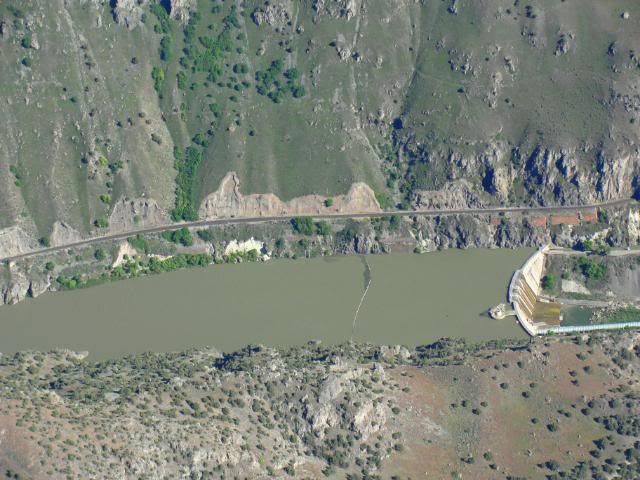
A couple of miles away from launch, the lift finally abated and turned into very mild sink, until from about 9,800' I was looking down on Cutler Dam
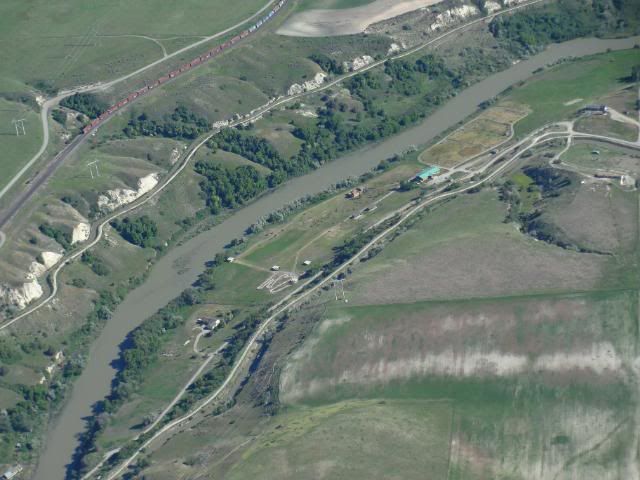
and Boy Scout Camp Fife.

I turned downwind, paused to enjoy an incredible view of the upper peaks from a new perspective, and then quickly made it back over Clarkston Peak with room to spare.
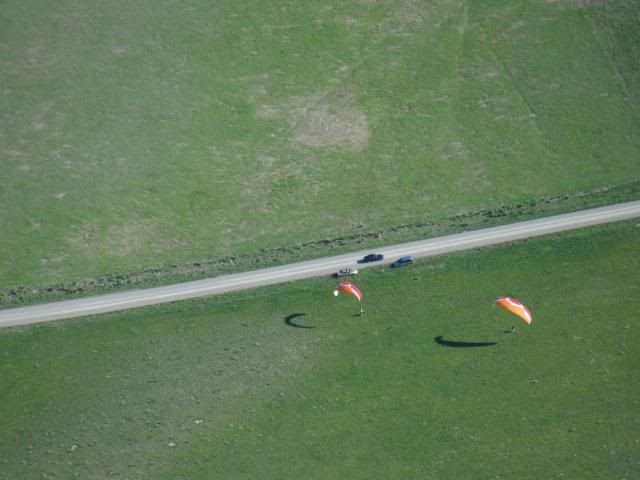
I watched some paragliders kiting in the LZ before I decided it was time to head for the barn.
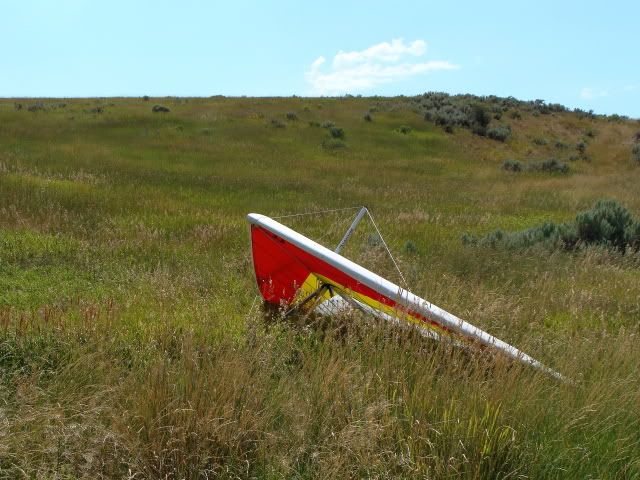
Landing Time: When flying XC the available lift and your ability to find it generally dictates landing time. A big part of a safe cross country journey is being able to determine conditions on the ground and select a safe landing zone from a thousand feet up, in often unfamiliar territory. When flying local glass-off conditions, we usually have the luxury of choosing landing time and location. I generally like to land well before sunset, to allow daylight to break down, retrieve my vehicle, and get home at a decent hour. Sometimes if I land too close to sunset, the winds on the ground will be zippo or switchy, making it trickier. If I land an hour or two before sunset, there will usually be a nice breeze to make landing easier. If I am high enough, I like to land on the Clarkston side because the LZ is uphill into the wind, all on a paved road, and a shorter drive back home for me.

Today I was plenty high to go over the back, work my way down through the lift over Clarkston, and come in for a nice stand-up landing.
I broke down and then made the 25 minute walk back to launch to retrieve my pick-up. I loaded up my glider, and was home by 8:30. What an awesome day and flight!
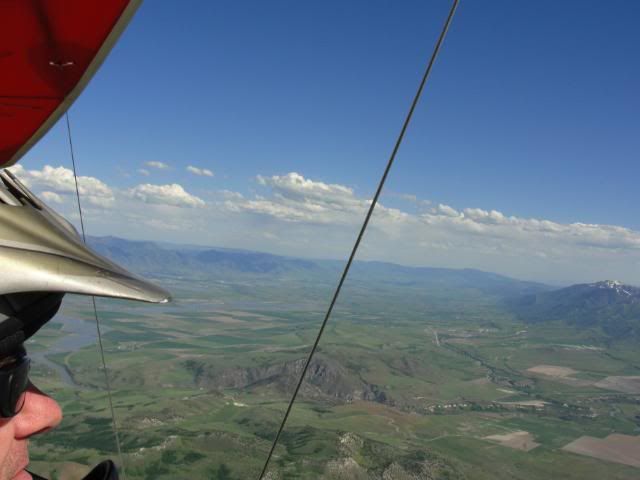
Airtime: 3 hrs 5 minutes!

Short Divide is mostly a low thermal launch, but there is a short ridge which can be soared if you have to "hang out" between up-cycles while waiting for a "ride to the top." Over the years, I've noticed a bit of a pattern for our flights here, which was obvious in today's flight:
Pre-planning: A forecast with moderately strong SW winds, along with a reasonably optimistic soaring forecast indicates good to excellent potential at Short Divide. A last minute check of the mesonet current winds before the 25 minute drive will generally confirm that conditions on launch are good.
Launch Window: Generally speaking, there will be an optimal launch window which will allow for "benching up" over Clarkston and Gunsight Peaks. Weather Underground can be helpful to determine the time of day that the winds will peak - which is usually around 3 pm. I try to be set up by peak anticipated wind time, and then assess the conditions. Going cross country will generally require launching a bit earlier - around 1-3 pm, to allow for more flying time when the lift is strongest. Launching earlier requires a higher "bump tolerance" - a willingness to fly in some turbulent "rodeo air", and do battle with some strong thermals.
If I am just looking to bench up and catch the glass-off, or maybe have a nice extended tandem flight, I will launch just as the winds peak and begin to stabilize, indicating a slight mellowing - still good lift, but not as "rock'n roll." This was the window that I chose today, launching at about 3:45 pm.
Launch Timing: Exactly when to launch is also important - especially because Short Divide is a lower elevation launch. Even on a day with good lift, there can be up & down cycles. I try to watch the wind through one up, then down cycle before launching, so I can time it well and launch just as an up cycle is starting, to allow me to immediately climb above launch where I have a better chance to bench up. Today I timed it well, but didn't get quite high enough to go back and climb the mountain before the "down cycle" came through. I quickly found myself below launch, struggling to find lift.

Generally speaking, once you bench up, the lift is much more plentiful, consistent and reliable. One of the great rewards of Short Divide is using your experience, skills and a little luck to climb out 3,000'+ over your launch elevation. I have always enjoyed climbing mountains on foot, but making the ascent in a hang glider results in a similar satisfaction - with even better outrageous views!
Go for Cloudbase: The next phase of most flights involves the "cat and mouse" game of coring the thermals and climbing as high as legally possible. This is one of my second-favorite parts of flying, because often times the lift just gets better and better the higher you get! The views just open up with each 360, until the patchwork valleys take on a Google Earth quality. At this point I am often joined by various raptors - today they include 2 Golden Eagles and 4 Red-tailed Hawks. On some days, the lift will only take me so high, until I bump up against an invisible ceiling. Sometimes persistence will allow me to break through this ceiling and continue to climb.

Decision Time: When I get above 10,000' the option of flying cross-country presents itself. I ask myself some key questions to make this decision: "Am I still climbing?" - Going XC in Utah generally (but not always) requires being able to climb consistently to at least 12,000' if not higher. "Am I physically prepared to go XC?" - Do I have warm clothes, water, food, radio, oxygen etc that I will need for climbing high and landing out? Am I in good overall physical condition? "Am I mentally prepared? - Is my head "in it", or do I have any distractions. Going cross country requires making a series of good, sound decisions in order to fly far and stay safe. "Do the conditions look good along my planned route?" - Is there a nice cloud street, or will it overdevelop and shut down? Are the winds aloft conducive to my planned route? Is the lift consistent enough - or is it one of those rare, "magical" days? "How will I get back?" - Do I have a chase driver below, or am I prepared to self-retrieve if needed? Can I afford to get home after midnight? Today I was prepared to go XC, but I could not climb any higher than about 9,600' over the top of Gunsight, so I decided to relax, explore and enjoy the flight.
Glass-Off: Most sites, generally in the summertime, to one degree or another, produce an afternoon/evening phenomena known as a glass-off - my favorite time of most flights! This is the time - usually between 2-4 hours before sunset - when the sun gets lower and the valley releases all of its stored heat, resulting in widespread abundant lift. The sharp-edged strong thermals soften, and what was a somewhat narrow lift band extends out over the valley - sometimes for miles! Some of these "wonder winds" will extend past sunset, even making it a challenge to get down. This time of the flight allows me to relax my grip on the control bar - or even fly hands-off - and just enjoy the magical air. These are the moments that are etched in my memories, which recharge my batteries for the coming ground-bound days ahead, as I have time to reflect, - and occasionally pinch myself to make sure I am not dreaming!

Today was just such a day. At about 5:30 pm I left the peaks, pulled on full VG and flew straight S/SE over the valley, as my vario chirped a smooth and steady 300 fpm up without even having to turn.

The view to the south of the Wellsville Mountains and Willard Peak was spectacular. The mountains, fields and valleys were all a vivid green from the recent Spring rains.

I topped out at about 10,600', and continued my southward course.

A couple of miles away from launch, the lift finally abated and turned into very mild sink, until from about 9,800' I was looking down on Cutler Dam

and Boy Scout Camp Fife.

I turned downwind, paused to enjoy an incredible view of the upper peaks from a new perspective, and then quickly made it back over Clarkston Peak with room to spare.

I watched some paragliders kiting in the LZ before I decided it was time to head for the barn.

Landing Time: When flying XC the available lift and your ability to find it generally dictates landing time. A big part of a safe cross country journey is being able to determine conditions on the ground and select a safe landing zone from a thousand feet up, in often unfamiliar territory. When flying local glass-off conditions, we usually have the luxury of choosing landing time and location. I generally like to land well before sunset, to allow daylight to break down, retrieve my vehicle, and get home at a decent hour. Sometimes if I land too close to sunset, the winds on the ground will be zippo or switchy, making it trickier. If I land an hour or two before sunset, there will usually be a nice breeze to make landing easier. If I am high enough, I like to land on the Clarkston side because the LZ is uphill into the wind, all on a paved road, and a shorter drive back home for me.

Today I was plenty high to go over the back, work my way down through the lift over Clarkston, and come in for a nice stand-up landing.
I broke down and then made the 25 minute walk back to launch to retrieve my pick-up. I loaded up my glider, and was home by 8:30. What an awesome day and flight!

Airtime: 3 hrs 5 minutes!








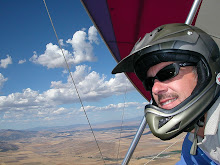

5 comments:
Glad you were able to go!!! It looked like it was a great time!
So cool - great day and good judgment on your part.
Too bad Brent/Toby couldn't have seen it --- or your mom but thanks for the beautiful shots. Happy for you !
yeehaa-it is sooooooooo neat that you share these flights with us. Such height, such air time, such views. Thanks for explaining what you consider and take into account in planning what you are going to do-xc, or whatever. I'm looking forward to your report on a xc venture that you are happy with. Thanks, Bud.
Love, Dad
Nice video Honey, I like the new perspective. :)
Great flight! So glad you had that opportunity. What supplies do you take with you when you go on a potential XC trip? (besides the tennis shoes and water bottle)
Post a Comment